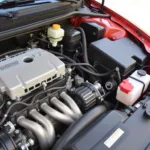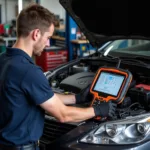The world of automotive diagnostics has been revolutionized by the advent of OBD2, or On-Board Diagnostics, second generation. These standardized protocols dictate how your vehicle communicates with diagnostic tools, enabling quicker and more efficient troubleshooting. This comprehensive guide delves into the intricacies of OBD2 norms, empowering you with the knowledge to understand your vehicle’s health like never before.
What are OBD2 Norms?
OBD2 norms, simply put, are a set of standardized rules and procedures governing the On-Board Diagnostics system in your car. Enacted in 1996 by the U.S. Environmental Protection Agency (EPA), these norms ensure that all vehicles manufactured after this period adhere to a uniform diagnostic framework. This standardization benefits car owners, mechanics, and manufacturers alike, facilitating a streamlined approach to vehicle diagnostics and repair.
The Importance of OBD2 Standards
Imagine a world without a universal language – communication would be chaotic. Similarly, before OBD2, car manufacturers utilized their own proprietary diagnostic systems, making it challenging for mechanics to accurately diagnose and repair vehicles across different makes and models. The introduction of OBD2 norms ushered in an era of uniformity, allowing a single OBD2 scanner to communicate effectively with any OBD2-compliant vehicle.
This standardization brought forth numerous benefits, including:
- Simplified Diagnostics: Mechanics can readily access vital vehicle data, making troubleshooting faster and more efficient.
- Reduced Repair Costs: Quicker diagnosis translates to reduced labor costs for car owners.
- Empowered Vehicle Owners: OBD2 scanners provide car owners with a window into their vehicle’s health, enabling them to monitor performance and identify potential issues proactively.
- Improved Environmental Protection: OBD2 regulations emphasize emission control, ensuring vehicles operate within acceptable environmental standards.
Key Components of OBD2 Norms
OBD2 norms encompass a range of specifications, including:
- Standardized Diagnostic Connector: All OBD2-compliant vehicles feature a 16-pin trapezoidal connector, ensuring compatibility with OBD2 scanners.
- Universal Communication Protocols: OBD2 mandates the use of specific communication protocols, allowing scanners to retrieve data from the vehicle’s Engine Control Unit (ECU) and other modules.
- Defined Diagnostic Trouble Codes (DTCs): OBD2 employs a standardized system of DTCs, representing specific faults detected in the vehicle’s systems. These codes streamline the diagnostic process and allow for more targeted repairs.
How OBD2 Norms Impact You
The influence of OBD2 norms extends far beyond the mechanic’s workshop, directly impacting every vehicle owner:
- Check Engine Light Demystified: OBD2 empowers you to understand the story behind that dreaded “Check Engine Light.” By retrieving and interpreting DTCs using an OBD2 scanner, you can gain insights into potential issues before they escalate.
- Proactive Maintenance: Regularly monitoring your vehicle’s health using an OBD2 scanner allows you to address minor problems before they turn into costly repairs. This preventative approach can save you money and extend the lifespan of your vehicle.
- Informed Repair Decisions: Armed with data from your OBD2 scanner, you can engage in more informed conversations with mechanics, ensuring transparency and preventing unnecessary repairs.
Expert Insight:
“OBD2 norms have been a game-changer in the automotive industry,” says John Miller, a seasoned automotive engineer with over 20 years of experience. “The standardization has not only streamlined the diagnostic process but has also empowered car owners to take a more proactive approach to vehicle maintenance.”
Conclusion
OBD2 norms have fundamentally transformed the way we interact with our vehicles. By understanding these standards and utilizing the power of OBD2 scanners, you can unlock a wealth of information about your car’s health, enabling you to make informed decisions regarding maintenance and repairs.
FAQs
1. Are all cars OBD2 compliant?
In the United States, all gasoline-powered vehicles manufactured after 1996 and diesel-powered vehicles manufactured after 1997 are OBD2 compliant.
2. What is a DTC?
DTC stands for Diagnostic Trouble Code. It is a standardized code that represents a specific fault detected in a vehicle’s system.
3. Can I clear my own DTCs?
While it is possible to clear DTCs using an OBD2 scanner, it is crucial to address the underlying issue causing the code to prevent further damage to your vehicle.
4. How often should I use an OBD2 scanner?
It is recommended to perform a scan at least once a month or before embarking on long journeys.
5. Where can I get more information about OBD2 scanners?
OBDFree offers a wealth of information about OBD2 scanners, including detailed reviews, comparisons, and guides. Visit our website or contact us for expert advice and assistance.
Need Help with OBD2 Scanners?
Contact our dedicated support team via WhatsApp: +1(641)206-8880, Email: [email protected]. We’re here to assist you 24/7.


